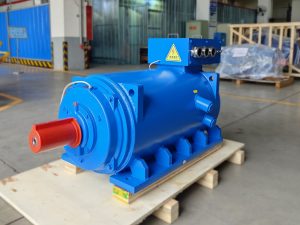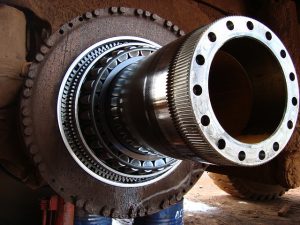Magnetic motors represent a huge leap in electromagnetic technology, affording great solutions to different areas of application. These motors use magnetic fields to effectively convert electrical energy into mechanical energy. As the industry continues to evolve, understanding the intricacies of magnetic drive performance optimization becomes essential for engineers and designers. This article focuses on the salient features of magnetic motors relating to the various factors contributing towards more efficiencies in performance yet remaining within the laws of electromagnetic technology.

Direct-drive magnetic motors do away with the need for extra mechanical components, allowing energy to be transferred more effectively from motor to load. Since they have fewer moving parts, wear and maintenance requirements are reduced. Typical applications include conveyor systems and robotics where precise motion control is critical. Direct-drive solutions also offer enhanced responsiveness and dynamic performance, making them ideal for high-speed applications.
Geared magnetic motors combine the strengths of traditional gearing systems with the need to enhance torque output while sustaining speed. Most of these motors have gearboxes that multiply the torque output of the motor, thus making them suitable for applications needing high force at relatively low speeds. Gearing allows versatility in design, enabling engineers to adapt motor characteristics to specific load requirements while still benefiting from the efficiency of magnetic drives.
In magnetic drives, torque transmission is achieved by magnetic fields without essentially having contact between the constituting parts. This avoids or minimizes friction loss, leading to less mechanical wear and increasing overall system efficiency. Power transmission can be transmitted by magnetic couplings or bearings in environments not ideal for conventional mechanical drive systems, such as those application areas concerning liquids or gases. The basic principle applied to the variable magnetic field strength for the control of motion and torque offers a wide range of versatility in operations for many applications.

Material selection is critical in magnetic drives based on their performance. Selection affects various factors to be considered, including but not limited to magnetic permeability, thermal conductivity, and structural integrity. Appropriate high-performance magnetic materials could be laminated silicon steel, and rare-earth magnets that might enhance magnetic flux, increasing the efficiency of drives. Not only does proper selection bring up the performance, but managing heat generation and losses increases operational life.
Common materials used in magnetic applications include silicon steel, ferrite magnets, and neodymium-iron-boron (NdFeB) magnets. Silicon steel has high magnetic permeability, and its hysteresis losses are low; it is, therefore, generally used. Ferrite magnets are a low-cost option with a wide range of applications. NdFeB magnets maintain strong magnetic fields in relatively small sizes, hence turning them into ideal choices in high-performance applications. Investigation of the proper balance can significantly affect the performance of magnetic drives.
Mechanical strength, thermal tolerance, and corrosion resistance are some of the factors that must be considered in selecting materials for magnetic drives. Durable materials are capable of withstanding operational stresses and environmental elements; hence, they have longer life spans and are more reliable. Moreover, optimizing such properties prevents the problem of demagnetization and thermal runaway, thus leading to better performance and efficiency in the system.
The integration of sensor technologies into magnetic motor systems has become an important factor in realizing efficiency and performance gains. Sensors, including encoders and temperature monitors, provide immediate feedback enabling dynamic control of the operation of motors. This will continuously monitor performance to optimize and yield energy savings, extend life, and also allow for predictive maintenance strategies.
PID controllers further enhance the performance of magnetic motors with accurate control of speed, position, and torque. These continuously calculate an error value, and after applying corrective actions, can improve responsiveness and stability in magnetic drive systems by orders of magnitude. Their deployment optimizes operation, and energy consumption, and prolongs motor life.
The principle behind liquid cooling techniques is gaining more ground in magnetic motor applications; for instance, in high performance. By circulating coolant either through or around the components of the motor, one can effectively dissipate excessively generated heat during operation; maintaining optimal temperatures. Moreover, this increases the electrical component reliability and life since it allows the motor to operate at higher power output without the risk of thermally-induced damage.
Air cooling remains one of the most common methods of dissipating heat in magnetic motors. This may be done by either forced air via fans or natural convection to dissipate the heat from the surface of the motor. Air cooling is easier and cheaper but may not be as effective in very harsh environments or high-performance applications. Properly designed air cooling techniques that match the application will provide enhanced performance and operational efficiency.
Enneng’s wide-ranging product portfolio includes a series of high-performance magnetic motors meant to fulfill diversified industry requirements for high-quality, sector-specific motors that guarantee optimized solutions in a wide range of applications while showing profound knowledge in magnetic drive principles. This is the exact flexibility that enables easy customizing for integration into existing systems, hence helping stakeholders in this industry achieve enhancement in operational performance.
The commitment of Enneng to innovation is sealed within its high-investing research and development program to raise the efficiency of magnetic motors. In this regard, the company introduced several technologies, among them the most developed magnetic material that ensures very high efficiency in energy transformation. Besides, R&D activities also cover intelligent solution-IoT in integrating the systems of motors to promote efficient monitoring and maintenance. With growing demand and the industry’s advancement, sustained investments by Enneng into breakthrough technologies ensure the same promise of redefining magnetic drive performance.

The long-term performance of magnetic motors relies on routine maintenance. In this case, one can identify the problem well before it results in some catastrophic failure and loss of integrity and performance of the motor. Based on operating hours and environment, schedules need to be developed for the timely checkup of magnetic motors. This also minimizes sudden stoppage at production lines or in an operational setting, rather than just extending the motor’s life.
Preventive maintenance strategies need to be designed for each application, depending on factors such as frequency of usage and load conditions on the motor. For example, where higher operational loads exist, more frequent checks might be necessary, whereas, for motors in benign environments, less strict schedules may suffice. The scheduling of such maintenance not only complies with manufacturers’ recommendations but is also generally good practice to extend component life. The documentation of all maintenance activities can further help in monitoring the performance trend over time for data-driven decisions.
This will inherently improve the impact of the regular maintenance routines: signs and symptoms of operational wear and tear, such as strange noises, overheating, or vibration anomalies, should be addressed without delay to prevent an operational failure. In such a way, advanced monitoring tools can allow the identification of symptoms indicative of motor health. Consequently, early remedial actions can be undertaken by the operator to preserve magnetic drive efficiency and reliability and help realize operational goals.
When upgrading components in magnetic motors becomes inevitable, careful compatibility must be addressed. Additions of new technology should not compromise the integrity of already installed components, and all engineers should study the proposed addition thoroughly before attempting to use it. Compatibility testing allows upgraded components to function with the rest of the motor system without interruption. This not only optimizes performance but also protects the investment made in sophisticated technological solutions.
Electrical upgrades focus on enhancing the efficiency of energy consumption in magnetic motors. Advanced power management systems can be introduced to optimize energy use at operations to reduce operational costs while maintaining high performance. Integrating high-efficiency transformers or inverters facilitates managing varied loads, thus allowing magnetic motors to adapt to real-time power requirements and make adjustments for better energy efficiency that helps extend the lifespan of critical components through reduced strain.
Mechanical improvements refer to the use of new and advanced materials and manufacturing processes that help enhance motor performance and durability. The structural integrity, for instance, can be enhanced by employing reinforced rotors and bearings, thereby reducing the tendency of mechanical failure. Additionally, precision engineering may reduce friction losses and enable higher operational speeds, hence enhancing overall drive performance. The condition of mechanical components should be checked periodically to ensure they are meeting high operational standards and facilitating effective magnetic drive.
Optimizing magnetic drive performance is a complex process that involves integration with advanced technology, frequent maintenance, selection of the right materials, and adopting innovative design practices. Enneng’s commitment to research and development underlines the importance of innovation in improving the efficiency of magnetic motors. By implementing scheduled maintenance regimes that take into account wear factors, operators can help elongate motor life and optimize performance. Continuous evolution, nurtured by Enneng and other firms in magnetic technologies, will lead to such progress in the future of the industry that magnetic motors will be assured of performing at high standards across all applications.